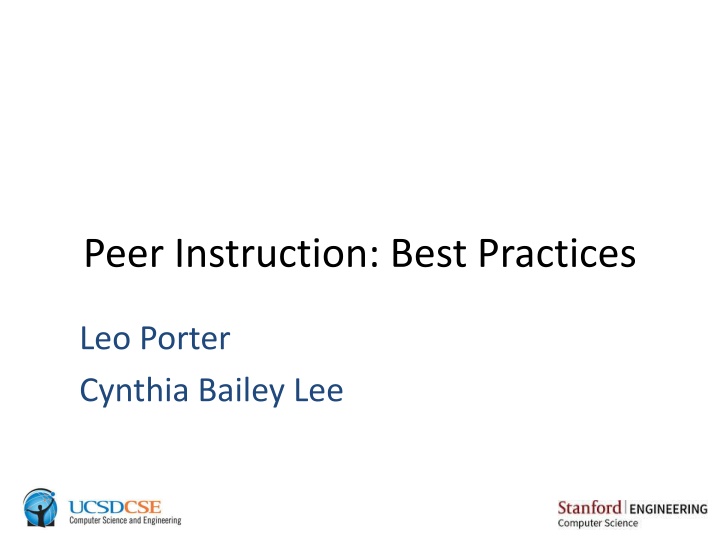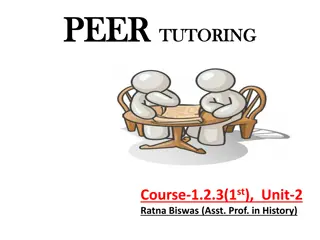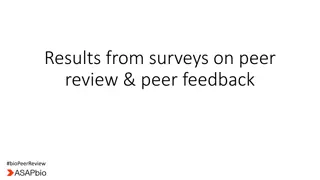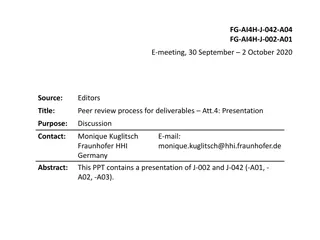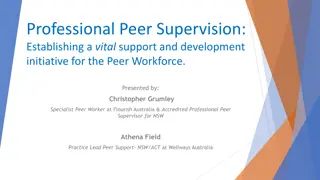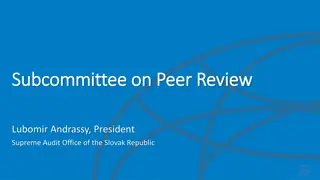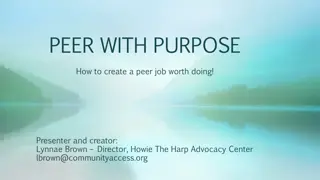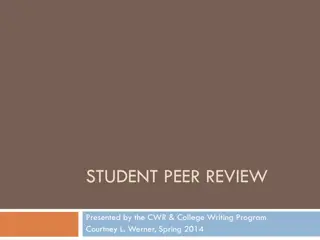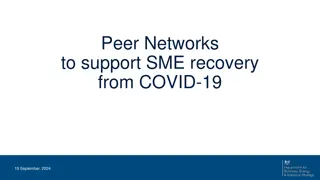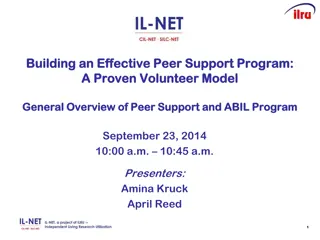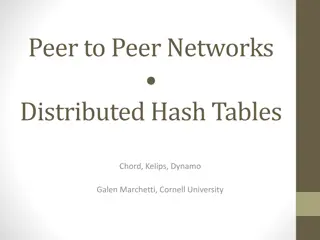Peer Instruction: Best Practices
This content showcases the effectiveness of Peer Instruction in improving conceptual learning, reducing failure rates, and enhancing student retention across various fields like physics and computer science. It highlights research findings, learning gains, and outcomes using Peer Instruction compared to traditional methods.
Download Presentation

Please find below an Image/Link to download the presentation.
The content on the website is provided AS IS for your information and personal use only. It may not be sold, licensed, or shared on other websites without obtaining consent from the author.If you encounter any issues during the download, it is possible that the publisher has removed the file from their server.
You are allowed to download the files provided on this website for personal or commercial use, subject to the condition that they are used lawfully. All files are the property of their respective owners.
The content on the website is provided AS IS for your information and personal use only. It may not be sold, licensed, or shared on other websites without obtaining consent from the author.
E N D
Presentation Transcript
Peer Instruction: Best Practices Leo Porter Cynthia Bailey Lee
Weve seen the results What PI offers Students Improved Conceptual Learning Measurable Learning During Class Reduction in Failure Rates Improved Retention of Majors Positive Learning Experiences More Feedback on their Learning
Introductory Physics Force Concept Inventory Example Question: A large truck runs into a small car head-on. The amount of force applied to the small car is: A. Less than that applied to the large truck B. Equal to that applied to the large truck C. Greater than that applied to the large truck
Physics Dramatic gains in Learning and it s not the instructor effect Traditional Instruction Peer Instruction Crouch, C., Mazur, E. Peer Instruction: Ten years of experience and results
Physics Learning Gains White=Traditional (T), n=14 Black = Interactive (IE), n=48 Average: Traditional: 0.23 0.04 Interactive: 0.48 0.14 Class Learning Gain n=62 classes Hake, R., Interactive-Engagement vs. Traditional Methods: A Six-Thousand-Student Survey of Mechanics Test Data for Introductory Physics Courses, American Journal of Physics, 1998.
Learning Outcomes - CS Examined Final Exam Performance in CS0 2 sections, same class, same professor Conscious effort to ensure same information exposure Identical Final Exams Simon, B., Harris, J, and Spacco, J. How We Teach Impacts Student Learning: Peer Instruction versus Lecture in CS0. SIGCSE 2013.
Final Exam Scores Standard 81.9% 13.1% 121 Overall Mean Std Dev N 84.5% 13.4% 208 Simon, B., Harris, J, and Spacco, J. How We Teach Impacts Student Learning: Peer Instruction versus Lecture in CS0. SIGCSE 2013. 8
Final Exam Scores Standard 81.9% 13.1% 121 Peer Instruction 88.0% 13.0% 87 Overall Mean Std Dev N 84.5% 13.4% 208 Simon, B., Harris, J, and Spacco, J. How We Teach Impacts Student Learning: Peer Instruction versus Lecture in CS0. SIGCSE 2013. 9
Failure Rates in CS1 Examined Fail Rates (D,F,W) for 10 years at UCSD (2001-2011) Data Set CS1 SI PI SI PI 18 9 5 4 Number of Classes Number of Different Instructors SI 1764 Total Enrollment PI 1296 Porter, L.; Lee, C.B.; Simon, B. Halving Fail Rates using Peer Instruction: A Study of Four Computer Science Classes. SIGCSE, March 2013.
CS1 Percent Fail Percent Withdraw 60% Peer Instruction Standard Instruction 50% Percentage of Students 40% 30% 20% 10% 0% (n= 96 ) Average Average + (n= 206 ) + (n= 128 ) + (n= 156 ) + (n= 172 ) + (n= 119 ) (n= 111 ) (n= 129 ) (n= 131 ) (n= 119 ) (n= 136 ) (n= 188 ) (n= 106 ) (n= 105 ) (n= 144 ) (n= 212 ) (n= 183 ) (n= 119 ) + (n= 45 ) + (n= 49 ) + (n= 54 ) + (n= 28 ) + (n= 82 ) + (n= 51 ) + (n= 31 ) + (n= 56 ) + (n= 94 ) SI PI SI PI + denotes WI or SP class
CS1 Percent Fail Percent Withdraw 60% Peer Instruction Standard Instruction 50% Percentage of Students 40% 30% 20% 10% 0% (n= 96 ) Average Average + (n= 206 ) + (n= 128 ) + (n= 156 ) + (n= 172 ) + (n= 119 ) (n= 111 ) (n= 129 ) (n= 131 ) (n= 119 ) (n= 136 ) (n= 188 ) (n= 106 ) (n= 105 ) (n= 144 ) (n= 212 ) (n= 183 ) (n= 119 ) + (n= 45 ) + (n= 49 ) + (n= 54 ) + (n= 28 ) + (n= 82 ) + (n= 51 ) + (n= 31 ) + (n= 56 ) + (n= 94 ) SI PI SI PI + denotes WI or SP class
CS1 Percent Fail Percent Withdraw 60% Peer Instruction Standard Instruction 50% Percentage of Students 40% 30% 20% 10% 0% (n= 96 ) Average Average + (n= 206 ) + (n= 128 ) + (n= 156 ) + (n= 172 ) + (n= 119 ) (n= 111 ) (n= 129 ) (n= 131 ) (n= 119 ) (n= 136 ) (n= 188 ) (n= 106 ) (n= 105 ) (n= 144 ) (n= 212 ) (n= 183 ) (n= 119 ) + (n= 45 ) + (n= 49 ) + (n= 54 ) + (n= 28 ) + (n= 82 ) + (n= 51 ) + (n= 31 ) + (n= 56 ) + (n= 94 ) SI PI SI PI + denotes WI or SP class
Not all PI Classes are the same N-A R1 Java N-B PUI Java N-C PUI Java E-D R1 E-E R1 Alice E-F R1 E-G PUI Java Institution Language Python Matlab Times Taught this 6 10+ 10+ 10+ 2 1 0 Course Students Completed 64 30 36 151 87 98 19 Course Percentage of CS 59% (ant.) 29% (decl.) 70% (ant.) 44% (ant.) 50% 1% 6.4% majors Clickers with discussion is valuable for my 74% 93% 100% 100% 94% 91% 93% learning. I recommend that other instructors use this approach (reading quizzes, clickers, in-class discussion) in their 71% 90% 100% 98% 93% 87% 100% courses. Publication pending.
An analogy You get a bacterial infection and the doctor gives you antibiotics. They tell you to take them for 10 days because after 10 days, the odds are high that the infection is gone. Could you stop at 6? Well maybe. But maybe not. If you re interested in faculty adoption of pedagogical practices, check out Charles Henderson s work! http://homepages.wmich.edu/~chenders/
Elements of Success Tell them why you re changing the class Make class a safe learning environment Reward participation and pre-class activities Be prepared for the unexpected Use your time wisely Ask difficult, important questions
THE FIRST DAY Some slides from Cynthia s first day of class!
The Basics: Your Grade 5% Clickers Participation only, not correctness Answer at least 80% to get credit for that lecture, drop 2 lectures 5% Reading quizzes (drop 1) 20% Homework (drop 1) 30% Midterm (two,15% each) 40% Final Exam 18
What do I do in class? Think of me as your tutor Be your guide in inducing you to explore concepts Create situations and pose problems that set the scene for yourexploration Answer your questions Notspend lecture reading the textbook to you with slightly different words 19
What do you do in class? (before class, you prepared yourself by reading the textbook and answering the reading quiz in Moodle) 1. I ask a question 2. You first answer it by yourself 3. Then discuss in assigned groups of 3-4 students Like a jury, you must come to a unanimous decision Answer the question a second time 4. I will ask groups to share their insights, and I will provide additional clarification as needed 20
But professor, wouldnt it be more efficient if you just taught us the right answer to begin with? Have you ever heard of a fitness class where the instructor did all the exercises at the front of class, while the class just watched attentively? Me neither. To learn, you must do the work with your own muscle (your brain). Image: Crossfit at lenoxspartanfitness.com 21
What do you do in this course? Prepare your brain for maximum in-class learning Reading, reading quizzes In class: engage with your neighbors and the class, engage with the ideas Turn them upside down and sideways, think about what common errors or misconceptions might be Seek help and seek to help others In class, moodle forums, office hours, discussion section I expect each class member to contribute to an environment of mutual aid and cooperation 22
Tips for a good group discussion Take turns being the first one to talk Once you all agree on the answer, don t stop! Always go over each wrong answer and explain why it is wrong Also interesting and useful to think about why somebody might be tempted to choose it how was Prof. Lovett hoping to trick somebody by including that wrong answer? Even if your group-mate has said something very clearly and correctly, it s a good idea to repeat it yourself So, what I think you said was, Might seem pointless, but your brain will remember better if YOU say it too 23
Rules for what you do in this course Reading quizzes Yes: Open book, though being able to answer book is a good sign You can retry a question if you answer incorrectly (small penalty), and you can take as much time as you need Complete them individually No: Sharing answers on a reading quiz is as inappropriate as sharing answers on an in-class exam don t do it 24
Handling a tech disaster Pretty much never happens, unless you are using iclicker Go app for phone/browser, which can be glitch Have students vote with raised fingers: one finger = A, 2 fingers = B, etc. Lost slides for the day? Use a question to buy time .
Encouraging volunteers in whole-class discussion Buy bulk candy after candy-heavy holidays (Halloween, Easter) Set a class goal for number of unique individuals speaking Let s see if we can get 10 different people to talk in class today. Also good for quieting that guy who always dominates now he s detracting from the class goal of getting many different people to speak
In-Class Time PI Questions take 3-8 minutes EACH Do NOT have 20 questions for a 50 minute lecture DO have 3-5 questions You will HAVE to cut some content This can be difficult Forces Depth vs. Breadth philosophy Pick what really matters Major concepts Common misconceptions
Take time to thinknow you have it! One of my favorite things about PI (and there are many!) is having time to pause during class and do a 1-minute reflection on how things are going Am I going too fast, too slow? Pick your I need to remember to do that public speaking to-do for the day now is your chance to check in on whether you re doing it
Elements of Success Tell them why you re changing the class Make class a safe learning environment Reward Participation and Pre-Class Activities Be prepared for the unexpected Use your time wisely Ask difficult, important questions Next Session will focus on questions, but first .
What are your current concerns? 20 minutes in groups, discuss the top 5 concerns most commonly mentioned about switching to PI We ll come back as a group to share best practices Keep notes during your session! Feel free to add your own They can be anything, from technical to administrative!
